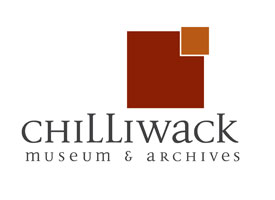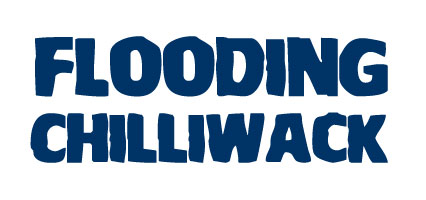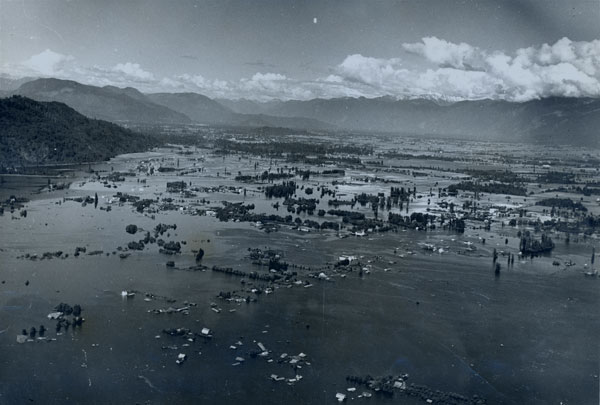

The Flood of 1948
Lead up to the Flood of 1948
Preventative measures were taken at the beginning of the century and by the mid-1920’s, after the Sumas Lake Reclamation project, the community felt protected from the forces of the rivers. Unfortunately, this led to the dykes being neglected and covered by trees and brush. In the years of 1947 and 1948 there was high snow accumulation in the mountains; in 1948, the early spring months were unseasonably cold which did not allow for normal spring run-off. High temperatures in May and warm rains triggered a high freshet with water levels rising in all major drainage basins in the Province.
The Flood
Some were sceptical about the flood warnings but others, those who had perhaps remembered the flood of 1894, were sure of the imminent danger. The people of Agassiz and Rosedale tried to reinforce the neglected dykes; the Rosedale dyke crew may have saved Chilliwack’s downtown from serious flooding. On May 26, 1948, the dyke in Agassiz broke as the river reached 21 feet at the Mission gauge. On May 28th the river reached 23.05 feet at the Mission gauge and there was a major break in the Semiault dyke which was soon repaired. By the end of May, the river had reached 24.08 feet at the Mission gauge and the Matsqui dyke had collapsed. The CNR railway was severed, breaking the railway connection between Vancouver and Eastern Canada. In early June, the waters reached their peak at 24.73 feet, just a foot less than the 1894 flood. Dykes continued to fail as the Cannor dyke broke and small breaks occurred in the Semiault dyke. People were evacuated from Greendale and Herrling Island and many evacuees found refuge at Cultus Lake. When people were finally able to return to their homes, their gardens and livestock had perished and their homes were damaged and covered with debris. [image: P672 Sumas United Church submerged during the 1948 flood].
Emergency Flood Committee
An Emergency Flood Control Committee was formed on May 27th which consisted of five branches: dykes, evacuation, Red Cross, police, transport and manpower. These branches worked toward preventing the flood and providing relief to those affected. Workers tried to raise and reinforce all of the dykes in the area. People were evacuated from numerous areas including Agassiz, Dewdney, Nicomen Island, Cottonwood Corner, Atchelitz Creek and some families along Vedder road and Sardis. The Emergency Flood Committee worked with Chilliwack residents around the clock to reduce the negative impact of the flood.
The Army
The Canadian army was arranged to assist during the crisis. They worked hard to provide access to dykes, clear dykes of overgrowth and fill sandbags as well as evacuate people and livestock from flooded areas. The equipment the army provided such as wireless communication and heavy equipment was invaluable.
Red Cross
Four Red Cross canteens were set up at the United Church Hall in Chilliwack, the hospital auxillary kitchen at the fairgrounds, the United Church Hall in Rosedale and in Yarrow. The canteens operated with the help of volunteers to provide food for the flood workers. All in all, the canteens provided 29 225 sandwiches, 1500 pounds of coffee and 290 cold drinks. The Red Cross provided grocery service to evacuees during the crisis and provided food for families once they returned to their homes. A Red Cross clothing depot was set up at City Hall (present day Chilliwack Museum).
After the flood waters receded, people returned to their neighbourhoods and homes to find extensive damage. Due to the risk of mould and contamination, the Department of Health outlined procedures for sterilizing homes and wells and residents required permission before they could permanently reside in their homes. Flood victims experienced economic hardship for years afterwards. [P675 United Church volunteers making sandwiches for flood workers, 1948].
Memories of the 1948 Flood: Dorothy Kostrzewa
Dorothy’s family lived in Chilliwack’s Chinatown during the 1948 flood. She remembers her brothers diving to retrieve their planted vegetables to eat: “I think that this is one of the things that we chuckle about is who can bring up the most vegetables and can hold their breath under water.” [image: P4512 aerial view of Greendale under water, 1948
Post 1948 River Management
After the flood of 1948, all the dykes were widened and heightened with gravel, silt and dirt. More dangerous points in the dykes were afforded additional protection; these included the Rosedale dyke, the Cannor dyke, the Vedder Canal and there was a new dyke built, the Glendale dyke. The network of dykes that now surround Chilliwack have been upgraded and maintained since 1948 to be sufficient against the flood levels of 1894 by being four feet above the high watermark.
The Fraser River dykes are composed of silt on the river side and gravel on the land side. Pressure is relieved through measures such as relief wells and dyke drains. Gravel is regularly removed from the Vedder Canal to contain the river between two set-back dykes. Gravel has also been removed from the Fraser River but gravel removal has become a controversial issue between environmentalists who are trying to protect fish habitat and government agencies trying to protect their communities.
The District of Chilliwack is responsible for the maintenance of the dykes and the drainage systems in Chilliwack but there are local and provincial programs in place, such as the Provincial Emergency Program, that will assist the community should the dyke systems fail.





Chilliwack Museum and Archives 45820 Spadina Avenue, Chilliwack, BC, Canada V20 1T3 [604.795.5210]

